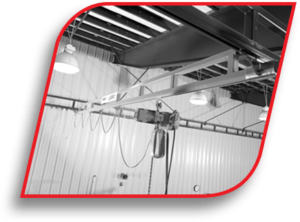
There are various ways to control the bridge drive movement of an overhead crane. However, just because you have movement does not necessarily mean you have the best option for your facility or crane operators.
From increasing capacity and productivity to reducing M&O costs, finding the right bridge drive can be crucial not only to the success of your business but the safety of your employees. Let’s explore some of the designs and options available, including geared systems, electric tractor drives, wound rotor motors, and variable frequency drives.
Geared Drives
Sometimes you don’t need an expensive electrical solution for your facility’s needs. A manually driven geared design that uses manpower instead of electrical power is ideal for situations where highly precise load movement is needed over short distances. You control the speed, the deceleration, and the position. Even though the concept is hundreds of years old, the technology available today means that you can take advantage of low friction, maintenance-free bearings, and a strong but still lightweight and compact design.
Electric Tractor Drives
Electric tractor drives, also called power drives, can be used for push-pull overhead crane operation, and offer high speeds and reduced worker fatigue. They come in various capacities, and there are several choices regarding the type of electric motor and accessories used. Two things we like to recommend to our customers are wound rotor motors and/or variable frequency drives.
Wound Rotor Motors
Also known as slip ring motors, wound motors require very little current to provide a high starting torque, even for loads with high inertia. Traditional “squirrel cage” three-phase induction motors have windings permanently short-circuited by an end ring. A slip ring motor, on the other hand, has a three-phase winding, and each of the winding terminals is connected to separate slip rings. This design, in addition to high starting torque and low current, also supports smooth acceleration and a degree of speed control. The drawback of these motors lies in their complexity and high level of maintenance.
Variable Frequency Drives (VFD)
VFD control is an alternative to more traditional 2-speed drive control. VFD offers multiple speeds, smoother acceleration, and regenerative braking capabilities. In addition, VFD means you can perform condition monitoring to support predictive and preventative maintenance, leading to shorter, more infrequent downtimes, reduced maintenance and repair costs, and a longer life for your hoist. And don’t forget that variable frequency drives can be very important to general overhead crane safety.
Why Your Choice Matters
If you have an older system, remember there are parts that will eventually become obsolete. This will lead to high maintenance and repair costs and long lead times that could adversely impact operational costs. Modernizing your crane with a newer drive system could save you money and reduce downtime. For example, tractor drives lead to faster speeds with a smoother motion, contributing to increased capacity and production for your facility.
Upgrading to a newer or updated motion control system provides better options for smoother acceleration and regenerative braking. This, in turn, reduces load swing, preventing damage to the load and, more importantly, injury to bystanders.
Conclusion
You may want to consider how you drive your cranes for many reasons. Increased production requirements may demand more capacity, faster-operating speeds, better controls, or automation. Reliability may have deteriorated, resulting in unscheduled shutdowns and increased production costs. Or you may simply be looking for a better motion control solution for your facility.
Whatever the reason, the experts at Hi-Speed Industrial Service have years of knowledge and experience in motors, controls, and cranes to help you evaluate your existing system or design a new one. Let our team help you find a solution that meets your needs without exceeding your budget. Give Hi-Speed a call today to learn more!

